Persian language

Persian language

| Persian | |
|---|---|
| (fārsi), (forsī) | |
| Pronunciation | |
| Native to | |
| 70 million[6](110 million total speakers)[5] | |
| Dialects | |
| Official status | |
| Regulated by | |
| Language codes | |
| – inclusive codeIndividual codes: –Iranian Persian–Dari–Tajik–Aimaq dialect–Bukhori dialect–Hazaragi dialect–Judeo-Persian–Pahlavani–Dehwari–Judeo-Tat–Caucasian Tat | |
| Glottolog | [8] |
| Linguasphere | |
Persian (/ˈpɜːrʒən, -ʃən/), also known by its endonym Farsi (فارسی, fārsi, [fɒːɾˈsiː] ( listen)), is a Western Iranian language belonging to the Iranian branch of the Indo-Iranian subdivision of the Indo-European languages. It is a pluricentric language predominantly spoken and used officially within Iran, Afghanistan and Tajikistan in three mutually intelligible standard varieties, namely Iranian Persian, Dari Persian (officially named Dari since 1958)[9] Tajiki Persian]](officially named [10] en natively in the Tajik variety by a significant population within Uzbekistan,[11][12]Tajikistan%20in%20the%20new%20Centra]] Persianate Greater Iran Afghanistan in the Persian alphabet, a derivation of the Arabic script, and within Tajikistan in the Tajik alphabet, a derivation of Cyrillic.
The Persian language is a continuation of Middle Persian, the official religious and literary language of the Sasanian Empire, itself a continuation of Old Persian, which was used in the Achaemenid Empire.[14][15] It originated in the region of Fars (Persia) in southwestern Iran.[16] Its grammar is similar to that of many European languages.[17]
Throughout history, Persian has been a prestigious cultural language used by various empires in Western Asia, Central Asia, and South Asia.[18] Old Persian written works are attested in Old Persian cuneiform on several inscriptions from between the 6th and the 4th centuries BC, and Middle Persian literature is attested in Aramaic-derived scripts (Pahlavi and Manichaean) on inscriptions from the time of the Parthian Empire and in books centered in Zoroastrian and Manichaean scriptures from between the 3rd to the 10th century AD. New Persian literature began to flourish after the Arab conquest of Iran with its earliest records from the 9th century, since then adopting the Arabic script.[19] Persian was the first language to break through the monopoly of Arabic on writing in the Muslim world, with the writing of Persian poetry developed as a court tradition in many eastern courts.[18] Some of the famous works of medieval Persian literature are the Shahnameh of Ferdowsi, the works of Rumi, the Rubaiyat of Omar Khayyam, the Panj Ganj of Nizami Ganjavi, the Divān of Hafez, The Conference of the Birds by Attar of Nishapur, and the miscellanea of Gulistan and Bustan by Saadi Shirazi.
Persian has left a considerable influence on its neighboring languages, including other Iranian languages, the Turkic languages, Armenian, Georgian and the Indo-Aryan languages (especially Urdu). It also exerted some influence on Arabic, particularly Bahrani Arabic,[20] while borrowing much vocabulary from it under medieval Arab rule.[14][17][21]Pahlav]] [22][23]
| Persian | |
|---|---|
| (fārsi), (forsī) | |
| Pronunciation | |
| Native to | |
| 70 million[6](110 million total speakers)[5] | |
| Dialects | |
| Official status | |
| Regulated by | |
| Language codes | |
| – inclusive codeIndividual codes: –Iranian Persian–Dari–Tajik–Aimaq dialect–Bukhori dialect–Hazaragi dialect–Judeo-Persian–Pahlavani–Dehwari–Judeo-Tat–Caucasian Tat | |
| Glottolog | [8] |
| Linguasphere | |
Classification
Persian is a member of the Western Iranian group of the Iranian languages, which make up a branch of the Indo-European languages in their Indo-Iranian subdivision. The Western Iranian languages themselves are divided into two subgroups: Southwestern Iranian languages, of which Persian is the most widely spoken, and Northwestern Iranian languages, of which Kurdish is the most widely spoken.[27]
Name
The term Persian is an English derivation of Latin Persiānus, the adjectival form of Persia, itself deriving from Greek Persís (Περσίς),[28] a Hellenized form of Old Persian Pārsa (𐎱𐎠𐎼𐎿),[29] which means "Persia" (a region in southwestern Iran, corresponding to modern-day Fars). According to the Oxford English Dictionary, the term Persian as a language name is first attested in English in the mid-16th century.[30]
Farsi, which is the Persian word for the Persian language, has also been used widely in English in recent decades, more commonly to refer to the standard Persian of Iran. However, the name Persian is still more widely used. The Academy of Persian Language and Literature has called for avoiding the use of the endonym Farsi in foreign languages and has maintained that Persian is the appropriate designation of the language in English, as it has the longer tradition in western languages and better expresses the role of the language as a mark of cultural and national continuity.[31] Eminent Iranian historian and linguist Ehsan Yarshater, founder of Encyclopædia Iranica and the Center for Iranian Studies at Columbia University, mentions the same concern in an academic journal on Iranology, rejecting the use of Farsi in foreign languages.[32]
Etymologically, the Persian term Fārsi derives from its earlier form Pārsi (Pārsik in Middle Persian), which in turn comes from the same root as the English term Persian.[33][34] The phonemic shift from /p/ to /f/ is a result of the medieval Arabic influences that followed the Arab conquest of Iran, and is due to the lack of the phoneme /p/ in Standard Arabic.[35]
Standard varieties' names
Dari Persian (فارسی دری, fārsi-ye dari), that is the standard Persian of Afghanistan, has been officially named Dari (دری, dari) since 1958.[9]*Islam%20and%20Politics%20in%20Afghan]]lso referred to as Pashto. The term urt", originally referred to the variety of Persian used in the court of the Sasanian Empire in capital Ctesiphon, which was spread to the northeast of the empire and gradually replaced the former Iranian dialects of Parthia (Parthian).[38][39]
Tajik Persian (форси́и тоҷикӣ́, forsi-i tojikī), that is the standard Persian of Tajikistan, has been officially designated as Tajik (тоҷикӣ, tojikī) since the time of the Soviet Union.[10] It is the name given to the varieties of Persian spoken in Central Asia, in general.[40]
ISO codes
The international language-encoding standard ISO 639-1 uses the code fa, as its coding system is mostly based on the native-language designations. The more detailed standard ISO 639-3 uses the name "Persian" (code fas) for the dialect continuum spoken across Iran and Afghanistan. This consists of the individual languages Dari (Afghan Persian) and Iranian Persian.[41]
History
In general, the Iranian languages are known from three periods, namely Old, Middle, and New (Modern).
These correspond to three historical eras of Iranian history; Old era being sometime around the Achaemenid Empire (i.e., 400–300 BC), Middle era being the next period most officially around the Sasanian Empire, and New era being the period afterwards down to present day.[42]
According to available documents, the Persian language is "the only Iranian language"[14] for which close philological relationships between all of its three stages are established and so that Old, Middle, and New Persian represent[14][43] one and the same language of Persian; that is, New Persian is a direct descendant of Middle and Old Persian.[43]
The known history of the Persian language can be divided into the following three distinct periods:
Old Persian

An Old Persian inscription written in Old Persian cuneiform in Persepolis, Iran.
As a written language, Old Persian is attested in royal Achaemenid inscriptions. The oldest known text written in Old Persian is from the Behistun Inscription, dating to the time of king Darius I (reigned 522-486 BC).[44] Examples of Old Persian have been found in what is now Iran, Romania (Gherla),[45][46][47] Armenia, Bahrain, Iraq, Turkey and Egypt.[48][49] Old Persian is one of the oldest Indo-European languages which is attested in original texts.[50]
Related to Old Persian, but from a different branch of the Iranian language family, was Avestan, the language of the Zoroastrian liturgical texts.
Middle Persian
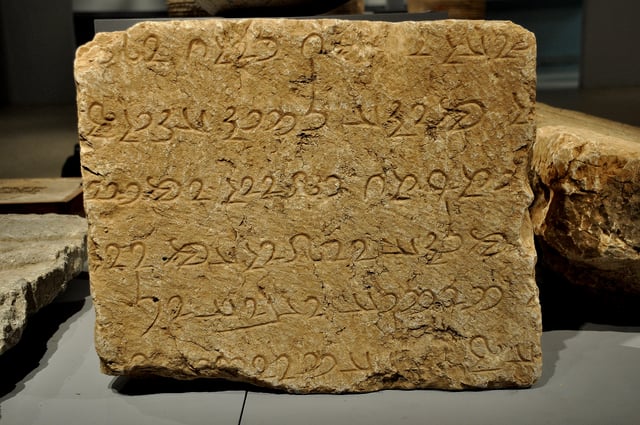
Middle Persian text written in Inscriptional Pahlavi on the Paikuli inscription from between 293 and 297. Slemani Museum, Iraqi Kurdistan.
The complex grammatical conjugation and declension of Old Persian yielded to the structure of Middle Persian in which the dual number disappeared, leaving only singular and plural, as did gender. Middle Persian developed the ezāfe construction, expressed through ī (modern ye), to indicate some of the relations between words that have been lost with the simplification of the earlier grammatical system.
Although the "middle period" of the Iranian languages formally begins with the fall of the Achaemenid Empire, the transition from Old to Middle Persian had probably already begun before the 4th century BC.
However, Middle Persian is not actually attested until 600 years later when it appears in the Sassanid era (224–651) inscriptions, so any form of the language before this date cannot be described with any degree of certainty.
Moreover, as a literary language, Middle Persian is not attested until much later, in the 6th or 7th century.
From the 8th century onward, Middle Persian gradually began yielding to New Persian, with the middle-period form only continuing in the texts of Zoroastrianism.
Middle Persian is considered to be a later form of the same dialect as Old Persian.[51] The native name of Middle Persian was Parsig or Parsik, after the name of the ethnic group of the southwest, that is, "of Pars", Old Persian Parsa, New Persian Fars. This is the origin of the name Farsi as it is today used to signify New Persian. Following the collapse of the Sassanid state, Parsik came to be applied exclusively to (either Middle or New) Persian that was written in the Arabic script. From about the 9th century onward, as Middle Persian was on the threshold of becoming New Persian, the older form of the language came to be erroneously called Pahlavi, which was actually but one of the writing systems used to render both Middle Persian as well as various other Middle Iranian languages. That writing system had previously been adopted by the Sassanids (who were Persians, i.e. from the southwest) from the preceding Arsacids (who were Parthians, i.e. from the northeast). While Ibn al-Muqaffa' (eighth century) still distinguished between Pahlavi (i.e. Parthian) and Persian (in Arabic text: al-Farisiyah) (i.e. Middle Persian), this distinction is not evident in Arab commentaries written after that date.
New Persian
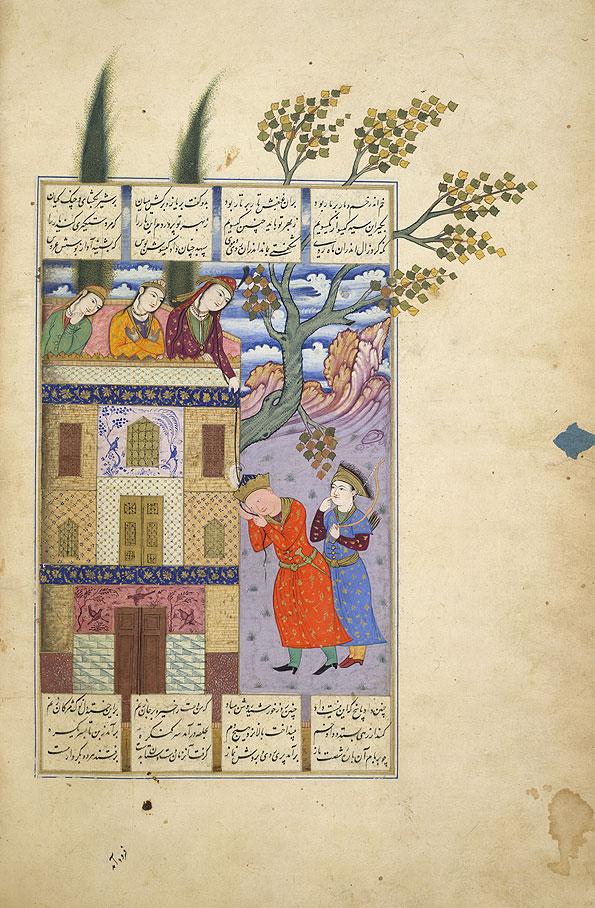
Ferdowsi's Shahnameh
"New Persian" (Modern) is conventionally divided into three stages:
Early New Persian (8th/9th centuries)
Classical Persian (10th–18th centuries)
Contemporary Persian (19th century to present)
Early New Persian remains largely intelligible to speakers of Contemporary Persian, as the morphology and, to a lesser extent, the lexicon of the language have remained relatively stable.[56]
Early New Persian
"New Persian" is taken to replace Middle Persian in the course of the 8th to 9th centuries, under Abbasid rule.[57] With the decline of the Abbasids began the re-establishment of Persian national life and Persians laid the foundations for a renaissance in the realm of letters.
New Persian as an independent literary language first emerges in Bactria through the adaptation of the spoken form of Sassanian Middle Persian court language called Pārsi-ye Dari. The cradle of the Persian literary renaissance lay in the east of Greater Iran in Greater Khorasan and Transoxiana close to the Amu Darya (modern day Afghanistan, Tajikstan, Uzbekistan and Turkmenistan).[58] The vocabulary of the New Persian language was thus heavily influenced by other Eastern Iranian languages, particularly Sogdian.[59]
The mastery of the newer speech having now been transformed from Middle into New Persian was already complete by the era of the three princely dynasties of Iranian origin, the Tahirid dynasty (820–872), Saffarid dynasty (860–903) and Samanid Empire (874–999), and could develop only in range and power of expression.[58]
Abbas of Merv is mentioned as being the earliest minstrel to chant verse in the newer Persian tongue and after him the poems of Hanzala Badghisi were among the most famous between the Persian-speakers of the time.[60]
The first poems of the Persian language, a language historically called Dari, emerged in Afghanistan.[61] The first significant Persian poet was Rudaki. He flourished in the 10th century, when the Samanids were at the height of their power. His reputation as a court poet and as an accomplished musician and singer has survived, although little of his poetry has been preserved. Among his lost works is versified fables collected in the Kalila wa Dimna.[18]
The language spread geographically from the 11th century on and was the medium through which among others, Central Asian Turks became familiar with Islam and urban culture.
New Persian was widely used as a trans-regional lingua franca, a task for which it was particularly suitable due to its relatively simple morphological structure and this situation persisted until at least 19th century.[57] In the late Middle Ages, new Islamic literary languages were created on the Persian model: Ottoman Turkish, Chagatai and Urdu, which are regarded as "structural daughter languages" of Persian.[57]
Classical Persian
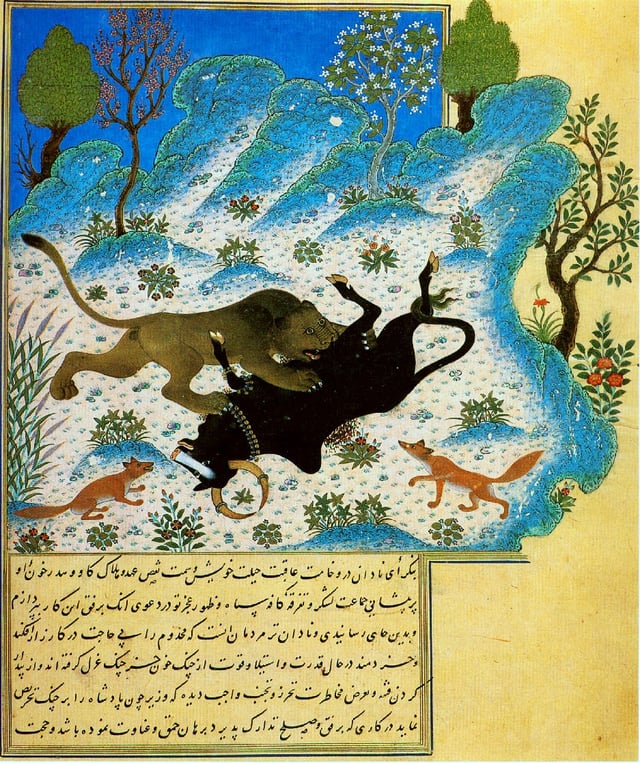
Kalilah va Dimna, an influential work in Persian literature
"Classical Persian" loosely refers to the standardized language of medieval Persia used in literature and poetry. This is the language of the 10th to 12th centuries, which continued to be used as literary language and lingua franca under the "Persianized" Turko-Mongol dynasties during the 12th to 15th centuries, and under restored Persian rule during the 16th to 19th centuries.[62]
Persian during this time served as lingua franca of Greater Persia and of much of the Indian subcontinent. It was also the official and cultural language of many Islamic dynasties, including the Samanids, Buyids, Tahirids, Ziyarids, the Mughal Empire, Timurids, Ghaznavids, Karakhanids, Seljuqs, Khwarazmians, the Sultanate of Rum, Delhi Sultanate, the Shirvanshahs, Safavids, Afsharids, Zands, Qajars, Khanate of Bukhara, Khanate of Kokand, Emirate of Bukhara, Khanate of Khiva, Ottomans and also many Mughal successors such as the Nizam of Hyderabad. Persian was the only non-European language known and used by Marco Polo at the Court of Kublai Khan and in his journeys through China.[63]
Use in Asia Minor
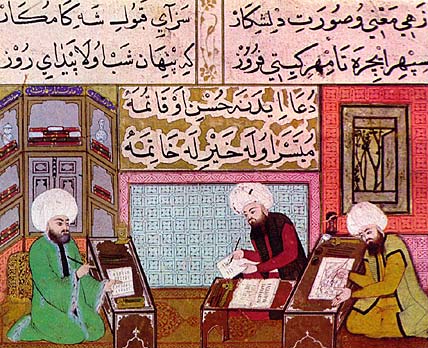
Persian on an Ottoman miniature.
Despite Anatolia having been ruled at various times prior to the Middle Ages by various Persian-speaking dynasties originating in Iran, the language lost its traditional foothold there with the demise of the Sasanian Empire. Centuries later however, the practise and usage of Persian in the region would be strongly revived. A branch of the Seljuks, the Sultanate of Rum, took Persian language, art and letters to Anatolia.[64] They adopted Persian language as the official language of the empire.[65] The Ottomans, which can roughly be seen as their eventual successors, took this tradition over. Persian was the official court language of the empire, and for some time, the official language of the empire.[66] The educated and noble class of the Ottoman Empire all spoke Persian, such as Sultan Selim I, despite being Safavid Iran's archrival and a staunch opposer of Shia Islam.[67] It was a major literary language in the empire.[68] Some of the noted earlier Persian works during the Ottoman rule are Idris Bidlisi's Hasht Bihisht, which began in 1502 and covered the reign of the first eight Ottoman rulers, and the Salim-Namah, a glorification of Selim I.[67] After a period of several centuries, Ottoman Turkish (which was highly Persianised itself) had developed towards a fully accepted language of literature, which was even able to satisfy the demands of a scientific presentation.[67] However, the number of Persian and Arabic loanwords contained in those works increased at times up to 88%.[67]
Use in South Asia
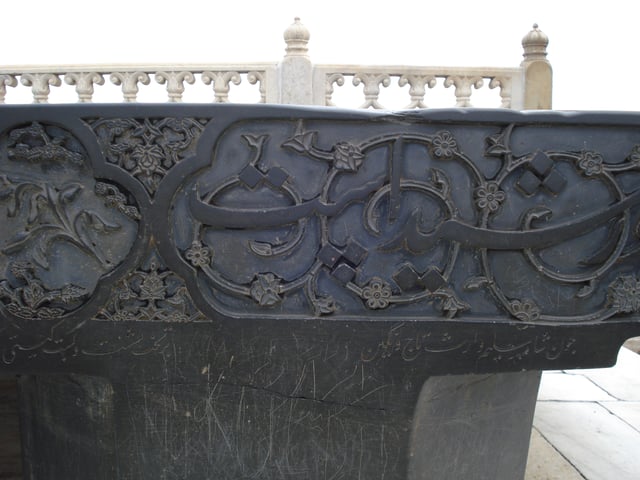
Persian poem, Agra Fort, India, 18th century
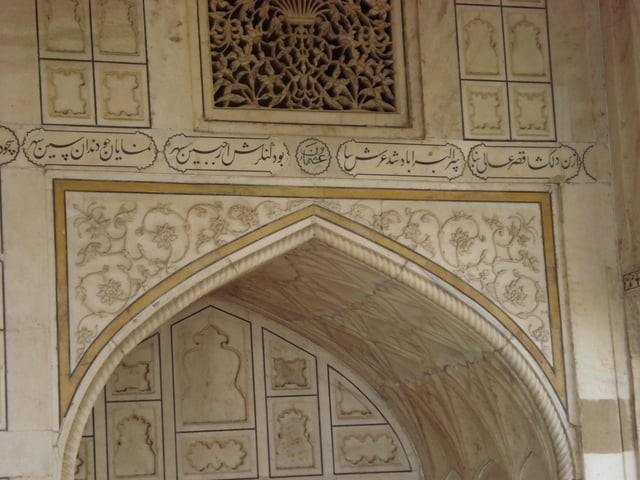
Persian poem, Takht-e Shah Jahan, Agra Fort, India
The Persian language influenced the formation of many modern languages in West Asia, Europe, Central Asia, and South Asia. Following the Turko-Persian Ghaznavid conquest of South Asia, Persian was firstly introduced in the region by Turkic Central Asians.[70] The basis in general for the introduction of Persian language into the subcontinent was set, from its earliest days, by various Persianized Central Asian Turkic and Afghan dynasties.[64] For five centuries prior to the British colonization, Persian was widely used as a second language in the Indian subcontinent, due to the admiration the Mughals (who were of Turco-Mongol origin) had for the foreign language. It took prominence as the language of culture and education in several Muslim courts on the subcontinent and became the sole "official language" under the Mughal emperors. Beginning in 1843, though, English and Hindustani gradually replaced Persian in importance on the subcontinent.[71] Evidence of Persian's historical influence there can be seen in the extent of its influence on certain languages of the Indian subcontinent. Words borrowed from Persian are still quite commonly used in certain Indo-Aryan languages, especially Urdu, also historically known as Hindustani. There is also a small population of Zoroastrian Iranis in India, who migrated in the 19th century to escape religious execution in Qajar Iran and speak a Dari dialect.
Contemporary Persian
Qajar dynasty
In the 19th century, under the Qajar dynasty, the dialect that is spoken in Tehran rose to prominence. There was still substantial Arabic vocabulary, but many of these words have been integrated into Persian phonology and grammar. In addition, under the Qajar rule numerous Russian, French, and English terms entered the Persian language, especially vocabulary related to technology.
The first official attentions to the necessity of protecting the Persian language against foreign words, and to the standardization of Persian orthography, were under the reign of Naser ed Din Shah of the Qajar dynasty in 1871. After Naser ed Din Shah, Mozaffar ed Din Shah ordered the establishment of the first Persian association in 1903.[31] This association officially declared that it used Persian and Arabic as acceptable sources for coining words. The ultimate goal was to prevent books from being printed with wrong use of words. According to the executive guarantee of this association, the government was responsible for wrongfully-printed books. Words coined by this association, such as rāh-āhan (راهآهن) for "railway", were printed in Soltani Newspaper; but the association was eventually closed due to inattention.
A scientific association was founded in 1911, resulting in a dictionary called Words of Scientific Association (لغت انجمن علمی), which was completed in the future and renamed Katouzian Dictionary (فرهنگ کاتوزیان).[72]
Pahlavi dynasty
The first academy for the Persian language was founded in May 20, 1935, under the name Academy of Iran. It was established by the initiative of Reza Shah Pahlavi, and mainly by Hekmat e Shirazi and Mohammad Ali Foroughi, all prominent names in the nationalist movement of the time. The academy was a key institution in the struggle to re-build Iran as a nation-state after the collapse of the Qajar dynasty. During the 1930s and 1940s, the academy led massive campaigns to replace the many Arabic, Russian, French, and Greek loanwords whose immense use in Persian during the centuries preceding the foundation of the Pahlavi dynasty had created a literary language considerably different from the spoken Persian of the time. This became the basis of what is now known as "Contemporary Standard Persian".
Varieties
There are three modern varieties of standard Persian:
Iranian Persian (Persian, Western Persian, or Farsi) is spoken in Iran, and by minorities in Iraq and the Persian Gulf states.
Eastern Persian (Dari Persian, Afghan Persian, or Dari) is spoken in Afghanistan.
Tajiki (Tajik Persian) is spoken in Tajikistan and Uzbekistan. It is written in the Cyrillic script.
All these three varieties are based on the classic Persian literature and its literary tradition.
There are also several local dialects from Iran, Afghanistan and Tajikistan which slightly differ from the standard Persian.
The Hazaragi dialect (in Central Afghanistan and Pakistan), Herati (in Western Afghanistan), Darwazi (in Afghanistan and Tajikistan), and the Tehrani accent (in Iran, the basis of standard Iranian Persian) are examples of these dialects. Persian-speaking peoples of Iran, Afghanistan, and Tajikistan can understand one another with a relatively high degree of mutual intelligibility.[73]
The following are some languages closely related to Persian, or in some cases are considered dialects:
Luri (or Lori), spoken mainly in the southwestern Iranian provinces of Lorestan, Kohgiluyeh and Boyer-Ahmad Province, some western parts of Fars Province and some parts of Khuzestan Province.
Lari (in southern Iran)
Tat, spoken in parts of Azerbaijan, Russia, and Transcaucasia. It is classified as a variety of Persian.[74][75][75][77][78] (This dialect is not to be confused with the Tati language of northwestern Iran, which is a member of a different branch of the Iranian languages.)
Judeo-Tat. Part of the Tat-Persian continuum, spoken in Azerbaijan, Russia, as well as by immigrant communities in Israel and New York.
For other more distantly related branches of the Iranian language family, such as Kurdish and Balochi, see Iranian languages.
Phonology
Iranian Persian has six vowels and twenty-three consonants.
Vowels

The vowel phonemes of modern Tehran Persian
Historically, Persian distinguished length.
Early New Persian had a series of five long vowels (/iː/, /uː/, /ɒː/, /oː/ and /eː/) along with three short vowels /æ/, /i/ and /u/. At some point prior to the 16th century in the general area now modern Iran, /eː/ and /iː/ merged into /iː/, and /oː/ and /uː/ merged into /uː/. Thus, older contrasts such as شیر shēr "lion" vs. شیر shīr "milk", and زود zūd "quick" vs زور zōr "strong" were lost. However, there are exceptions to this rule, and in some words, ē and ō are merged into the diphthongs [eɪ] and [oʊ] (which are descendants of the diphthongs [æɪ] and [æʊ] in Early New Persian), instead of merging into /iː/ and /uː/. Examples of the exception can be found in words such as روشن [roʊʃæn] (bright). Numerous other instances exist.
However, in Dari, the archaic distinction of /eː/ and /iː/ (respectively known as یای مجهول Yā-ye majhūl and یای معروف Yā-ye ma'rūf) is still preserved as well as the distinction of /oː/ and /uː/ (known as واو مجهول Wāw-e majhūl and واو معروف Wāw-e ma'rūf). On the other hand, in standard Tajik, the length distinction has disappeared, and /iː/ merged with /i/ and /uː/ with /u/.[79] Therefore, contemporary Afghan Dari dialects are the closest to the vowel inventory of Early New Persian.
According to most studies on the subject (e.g. Samareh 1977, Pisowicz 1985, Najafi 2001), the three vowels traditionally considered long (/i/, /u/, /ɒ/) are currently distinguished from their short counterparts (/e/, /o/, /æ/) by position of articulation rather than by length.
However, there are studies (e.g. Hayes 1979, Windfuhr 1979) that consider vowel length to be the active feature of the system, with /ɒ/, /i/, and /u/ phonologically long or bimoraic and /æ/, /e/, and /o/ phonologically short or monomoraic.
There are also some studies that consider quality and quantity to be both active in the Iranian system (such as Toosarvandani 2004).
That offers a synthetic analysis including both quality and quantity, which often suggests that Modern Persian vowels are in a transition state between the quantitative system of Classical Persian and a hypothetical future Iranian language, which will eliminate all traces of quantity and retain quality as the only active feature.
The length distinction is still strictly observed by careful reciters of classic-style poetry for all varieties (including Tajik).
Consonants
| Labial | Alveolar | Postalveolar | Palatal | Velar | Uvular | Glottal | |
|---|---|---|---|---|---|---|---|
| Nasal | m | n | ŋ | ||||
| Plosive | pb | td | kɡ | (q)ɢ | |||
| Affricate | tʃdʒ | ||||||
| Fricative | fv | sz | ʃʒ | xɣ | h | ||
| Flap or Tap | ɾ | ||||||
| Approximant | l | j |
Notes:
Grammar
Morphology
Suffixes predominate Persian morphology, though there are a small number of prefixes.[83] Verbs can express tense and aspect, and they agree with the subject in person and number.[84] There is no grammatical gender in Persian, and pronouns are not marked for natural gender.
Syntax
Normal declarative sentences are structured as (S) (PP) (O) V: sentences have optional subjects, prepositional phrases, and objects followed by a compulsory verb. If the object is specific, the object is followed by the word rā and precedes prepositional phrases: * (S) (O +rā) (PP) V*.[84]
Vocabulary
Native word formation
Persian makes extensive use of word building and combining affixes, stems, nouns and adjectives.
Persian frequently uses derivational agglutination to form new words from nouns, adjectives, and verbal stems. New words are extensively formed by compounding – two existing words combining into a new one, as is common in German.
Influences
While having a lesser influence on Arabic[22] and other languages of Mesopotamia and its core vocabulary being of Middle Persian origin,[17] New Persian contains a considerable amount of Arabic lexical items,[14][21]Pahlav]] [23] which were PersianizedArabic igin especially include Islamic terms. The Arabic vocabulary in other Iranian, Turkic and Indic languages is generally understood to have been copied from New Persian, not from Arabic itself.[85]
John R. Perry, in his article Lexical Areas and Semantic Fields of Arabic, estimates that about 24 percent of an everyday vocabulary of 20,000 words in current Persian, and more than 25 percent of the vocabulary of classical and modern Persian literature, are of Arabic origin. The text frequency of these loan words is generally lower and varies by style and topic area. It may approach 25 percent of a text in literature.[85] According to another source, about 40% of everyday Persian literary vocabulary is of Arabic origin.[87] Among the Arabic loan words, relatively few (14 percent) are from the semantic domain of material culture, while a larger number are from domains of intellectual and spiritual life.[88] Most of the Arabic words used in Persian are either synonyms of native terms or could be glossed in Persian.[89]
The inclusion of Mongolic and Turkic elements in the Persian language should also be mentioned,[90] not only because of the political role a succession of Turkic dynasties played in Iranian history, but also because of the immense prestige Persian language and literature enjoyed in the wider (non-Arab) Islamic world, which was often ruled by sultans and emirs with a Turkic background. The Turkish and Mongolian vocabulary in Persian is minor in comparison to that of Arabic and these words were mainly confined to military, pastoral terms and political sector (titles, administration, etc.).[91]*Encyclopedia%20Iran]]ew military and political titles were coined based partially on Middle Persian (e.g. ارتش tead of the Uzbek قؤشین qoʻshin; سرلشکر sarlaškar; دریابان daryābān; etc.) in the 20th century. Persian has likewise influenced the vocabularies of other languages, especially other Indo-European languages such as Armenian,[92] Urdu, Bengali and (to a lesser extent) Hindi; the latter three through conquests of Persianized Central Asian Turkic and Afghan invaders;[70] Turkic languages such as Ottoman Turkish, Chagatai, Tatar, Turkish,[94] Turkmen, Azeri,[95] Uzbek, and Karachay-Balkar;[96] Caucasian languages such as Georgian,[97] and to a lesser extent, Avar and Lezgin;[98] Afro-Asiatic languages like Assyrian (List of loanwords in Assyrian Neo-Aramaic) and Arabic;[99] and even Dravidian languages indirectly especially Telugu and Brahui; as well as Austronesian languages such as Indonesian and Malay. Persian has also had a significant lexical influence, via Turkish, on Albanian, Serbian, Croatian, Bosnian, and Serbo-Croatian, particularly as spoken in Bosnia and Herzegovina.
Use of occasional foreign synonyms instead of Persian words can be a common practice in everyday communications as an alternative expression.
In some instances in addition to the Persian vocabulary, the equivalent synonyms from multiple foreign languages can be used.
For example, in Iranian colloquial Persian (not in Afghanistan or Tajikistan), the phrase "thank you" may be expressed using the French word مرسی merci (stressed, however, on the first syllable), the hybrid Persian-Arabic phrase متشکّر ام motešakker am (متشکّر motešakker being "thankful" in Arabic, commonly pronounced motčakker in Persian, and the verb ام am meaning "I am" in Persian), or by the pure Persian phrase سپاسگزارم sepās-gozār am.
Orthography
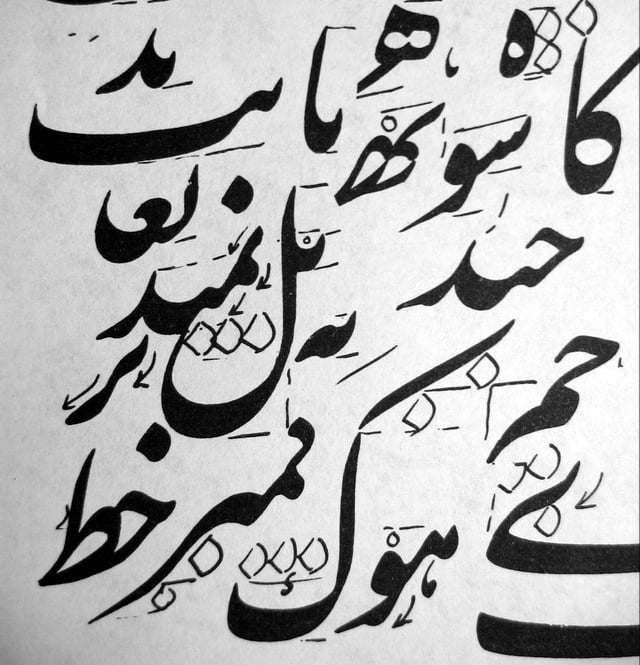
Example showing Nastaʿlīq's (Persian) proportion rules.
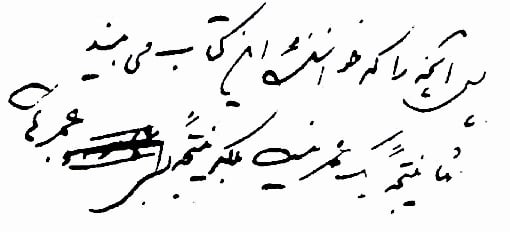
Ali-Akbar Dehkhoda's personal handwriting, a typical cursive Persian script.

The word Persian in the Book Pahlavi script
The vast majority of modern Iranian Persian and Dari text is written with the Arabic script. Tajiki, which is considered by some linguists to be a Persian dialect influenced by Russian and the Turkic languages of Central Asia,[100][101] is written with the Cyrillic script in Tajikistan (see Tajik alphabet). There also exist several romanization systems for Persian.
Persian alphabet

Persian typewriter keyboard layout
Modern Iranian Persian and Afghan Persian are written using the Persian alphabet which is a modified variant of the Arabic alphabet, which uses different pronunciation and additional letters not found in Arabic language. After the Muslim conquest of Persia, it took approximately 200 years which is referred to as Two Centuries of Silence in Iran, before Persians adopted the Arabic script in place of the older alphabet. Previously, two different scripts were used, Pahlavi, used for Middle Persian, and the Avestan alphabet (in Persian, Dīndapirak or Din Dabire—literally: religion script), used for religious purposes, primarily for the Avestan but sometimes for Middle Persian.
In the modern Persian script, historically short vowels are usually not written, only the historically long ones are represented in the text, so words distinguished from each other only by short vowels are ambiguous in writing: Iranian Persian kerm "worm", karam "generosity", kerem "cream", and krom "chrome" are all spelled krm (کرم) in Persian. The reader must determine the word from context. The Arabic system of vocalization marks known as harakat is also used in Persian, although some of the symbols have different pronunciations. For example, a ḍammah
There are several letters generally only used in Arabic loanwords.
These letters are pronounced the same as similar Persian letters.
For example, there are four functionally identical letters for /z/ (ز ذ ض ظ), three letters for /s/ (س ص ث), two letters for /t/ (ط ت), two letters for /h/ (ح ه). On the other hand, there are four letters that don't exist in Arabic پ چ ژ گ.
Additions
The Persian alphabet adds four letters to the Arabic alphabet:
| Sound | Isolated form | Name |
|---|---|---|
| /p/ | پ | pe |
| /tʃ/ | چ | če (che) |
| /ʒ/ | ژ | že (zhe or jhe) |
| /ɡ/ | گ | ge (gāf) |
Historically, there was also a special letter for the sound /β/.
This letter is no longer used, as the /β/-sound changed to /b/, e.g. archaic زڤان /zaβān/ > زبان /zæbɒn/ 'language'[39]
| Sound | Isolated form | Name |
|---|---|---|
| /β/ | ڤ | βe |
Variations
The Persian alphabet also modifies some letters of the Arabic alphabet.
For example, alef with hamza below ( إ ) changes to alef ( ا ); words using various hamzas get spelled with yet another kind of hamza (so that مسؤول becomes مسئول) even though the latter is also correct in Arabic; and teh marbuta ( ة ) changes to heh ( ه ) or teh
The letters different in shape are:
| Arabic Style letter | Persian Style letter | name |
|---|---|---|
| ك | ک | ke(kāf) |
| ي | ی | ye |
Latin alphabet
The International Organization for Standardization has published a standard for simplified transliteration of Persian into Latin, ISO 233-3, titled "Information and documentation – Transliteration of Arabic characters into Latin characters – Part 3: Persian language – Simplified transliteration"[103] but the transliteration scheme is not in widespread use.
Another Latin alphabet, based on the Common Turkic Alphabet, was used in Tajikistan in the 1920s and 1930s. The alphabet was phased out in favor of Cyrillic in the late 1930s.[100]
Fingilish is Persian using ISO basic Latin alphabet. It is most commonly used in chat, emails and SMS applications. The orthography is not standardized, and varies among writers and even media (for example, typing 'aa' for the [ɒ] phoneme is easier on computer keyboards than on cellphone keyboards, resulting in smaller usage of the combination on cellphones).
Tajik alphabet
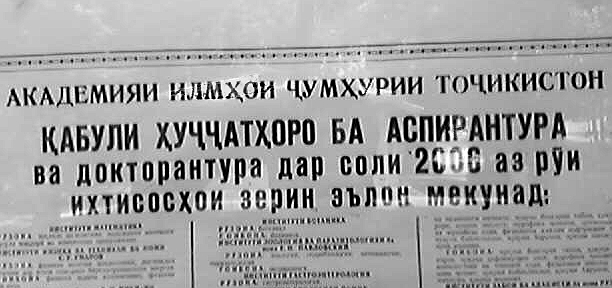
Tajiki advertisement for an academy
The Cyrillic script was introduced for writing the Tajik language under the Tajik Soviet Socialist Republic in the late 1930s, replacing the Latin alphabet that had been used since the October Revolution and the Persian script that had been used earlier. After 1939, materials published in Persian in the Persian script were banned from the country.[100][104]
Examples
The following text is from Article 1 of the Universal Declaration of Human Rights.
| Iranian Persian | همهی افراد بشر آزاد به دنیا میآیند و حیثیت و حقوقشان با هم برابر است، همه اندیشه و وجدان دارند و باید در برابر یکدیگر با روح برادری رفتار کنند. |
|---|---|
| Iranian Persiantransliteration | |
| Iranian PersianIPA | [hæmeje æfrɒde bæʃær ɒzɒd be donjɒ miɒjænd o hejsijæt o hoɢuɢe ʃɒn bɒ hæm bærɒbær æst hæme ʃɒn ændiʃe o vedʒdɒn dɒrænd o bɒjæd dær bærɒbære jekdiɡær bɒ ruhe bærɒdæri ræftɒr konænd] |
| Tajiki | Ҳамаи афроди башар озод ба дунё меоянд ва ҳайсияту ҳуқуқашон бо ҳам баробар аст, ҳамаашон андешаву виҷдон доранд ва бояд дар баробари якдигар бо рӯҳи бародарӣ рафтор кунанд. |
| Englishtranslation | All human beings are born free and equal in dignity and rights.They are endowed with reason and conscience and should act towards one another in a spirit of brotherhood. |
See also
Indo-European copula
Academy of Persian Language and Literature
Pahlavi (disambiguation)
List of English words of Persian origin
List of French loanwords in Persian
Persian Braille
Persian name
Persian metres
Romanization of Persian